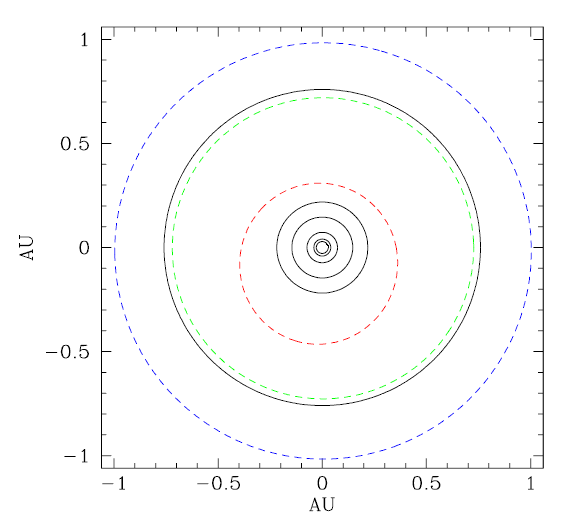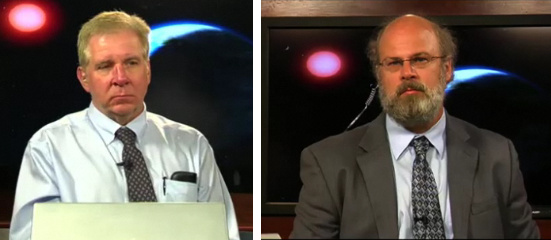Gliese 581g
October 1, 2010
I reviewed the search for
extrasolar planets in a
previous article (Extrasolar Planets, April 26, 2007). The first confirmed detection of an extrasolar planet didn't occur until 1995, but now there are nearly 500. Most of these are huge planets, much larger than
Earth, not for any other reason than those are the
easiest to detect. Most of these have been detected by looking at the star, and not the planets themselves. As a planet orbits its star, gravitational force causes a slight movement of the star. Actually, both the star and planet orbit about a point called the
barycenter, which is usually a point deep inside the star. The position of the star is not measured in detecting exoplanets, since that type of measurement is imprecise. Instead, advanced
spectrometric techniques measure the change in velocity of a star caused by the motion of its planets.
The star
Gliese 581 (Right Ascension 15h 19m 26s, Declination 07
o 43' 20") is a close star, just 20.5
light years away, in the constellation
Libra. How does a star get a name like Gliese 581? Gliese 581 is listed in a 1969 catalog of stars created by astronomer
Wilhelm Gliese, who complied this catalog of all stars within about eighty light years of Earth. Gliese 581 is the 581th entry in this catalog. A new planet has been detected around Gliese 581. This planet is named
Gliese 581g, the "g" designation indicating that it's the sixth detected planet of that star (the star itself is designated as object "a").
Another planet,
Gliese 581c, made news when it was discovered in 2007, since it appeared to have conditions close to that of Earth. Well, let's just say more like Earth than other detected planets, since it's about five times the mass of the Earth, with a surface gravity more than twice that of Earth. Gliese 581c is very close to its star (6.7 million miles), as indicated by its short orbital period of just thirteen days. Since Gliese 581 is a red dwarf, much cooler than the Sun, the average temperature of Gliese 581c is estimated to be between 0 and 40
oC, so liquid water can exist.
The newly discovered Gliese 581g is a bit more exciting. It orbits with a period of 36.6 days in the "habitable zone" of Gliese 581, a place where liquid water can exist. The popular press has dubbed this the "Goldilocks Zone," since it's a place where temperatures are neither too hot, nor too cold, for the existence of liquid water. The discovery was based on 11 years of observations by astronomers at the
University of California, Santa Cruz, and the
Carnegie Institution of Washington. The observations used the HIRES spectrometer on the Keck I Telescope at the
W. M. Keck Observatory (
Mauna Kea, Hawaii). Gliese 581g is right in the middle of the habitable zone, although it's three or four times the mass of the Earth. One of the principal investigator for the project, Steven Vogt, professor of astronomy and astrophysics at UC Santa Cruz, said[1]
"Our findings offer a very compelling case for a potentially habitable planet. The fact that we were able to detect this planet so quickly and so nearby tells us that planets like this must be really common... We had planets on both sides of the habitable zone--one too hot and one too cold--and now we have one in the middle that's just right."

The Gliese 581 solar system, compared with our own solar system. Earth, Venus, and
Mercury are shown as dashed blue, green, and red lines respectively. (via arXiv, Ref. 8).
An article on this discovery has been published in
The Astrophysical Journal by the principal Investigators, Steve Vogt of UCSC and Paul Butler of the Carnegie Institution of Washington, along with Eugenio Rivera of UC Santa Cruz, Nader Haghighipour of the
University of Hawaii-Manoa; and Gregory Henry and Michael Williamson of
Tennessee State University.[8] The paper not only announces the discovery of Gliese 581g, but also the discovery of planet Gliese 581f, which is about seven Earth masses with an orbital period of 433 days. The paper further refines the data for the other Gliese 581 planets.[8]
Gliese 581g does have some peculiarities. It's
tidally locked to its star, much like the
Moon is tidally locked to Earth. This means that one face of the planet is always in light, and the opposite face is always in darkness. This arrangement does lead to a temperate zone between the two, and a broad range of temperatures hospitable to life. It might be that the
origin of life is more likely in a hot climate, but survival of life is more likely in a cooler climate, so there are advantages. Nothing is known about an atmosphere, although the planet's mass is enough to
keep an atmosphere from escaping to space.

Steve Vogt and Paul Butler (via NSF, Ref. 2).
Vogt calls Gliese 581g, "Zarmina," in honor of his wife.[7] The question naturally arises as to whether there may be intelligent Zarminites on Gliese 581g. Since Gliese 581 is so very close to earth (relatively speaking), this star has been scanned for radio signals by the
SETI Institute. If they found anything, we would have heard about it. In any event, once
warp drive is invented, it might make a nice vacation spot, since you'll have year-round swimming and skiing within a few hundred miles of each other. I thought of the perfect advertising campaign, "
Gliese is Nice." Unfortunately, "Gliese" isn't pronounced that way.[2]
References:
- Newly Discovered Planet May Be First Truly Habitable Exoplanet, National Science Foundation Press Release No. 10-172, September 29, 2010.
- Steven Vogt and Paul Butler interviewed by Lisa-Joy Zgorski, National Science Foundation Press Release No. 10-172 (video), September 29, 2010.
- Tim Stephens, "Newly discovered planet may be first truly habitable exoplanet," UCSC Press Release, September 29, 2010.
- Katia Moskvitch, "A distant Earth-like exoplanet 'could have life'," BBC News, September 30, 2010.
- John Timmer, "Planet hunters find exoplanet that could potentially support life," Arstechnica, September 30, 2010.
- John Matson, "A newfound 'super-Earth' just 20 light-years away appears to reside in the habitable zone of its host star," Scientific American, September 30, 2010.
- "Newly discovered planet may be most Earth-like ever, astronomer says," LA Times, September 30, 2010.
- Steven S. Vogt, R. Paul Butler, Eugenio J. Rivera, Nader Haghighipour, Gregory W. Henry, Michael H. Williamson, "The Lick-Carnegie Exoplanet Survey: A 3.1 M_Earth Planet in the Habitable Zone of the Nearby M3V Star Gliese 581," arXiv Preprint, September 29, 2010. Available as a PDF file here and here.
Permanent Link to this article
Linked Keywords: Extrasolar planets; Earth; sampling bias; barycenter; spectrometric; Gliese 581; light year; Libra; Wilhelm Gliese; Gliese 581g; Gliese 581c; University of California, Santa Cruz; Carnegie Institution of Washington; W. M. Keck Observatory; Mauna Kea, Hawaii; The Astrophysical Journal; University of Hawaii-Manoa; Tennessee State University; tidal locking; Moon; abiogenesis; origin of life; atmospheric escape; SETI Institute; warp drive; Rice is Nice.